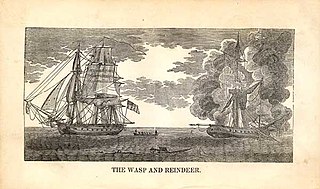USS Growler has been the name of more than one United States Navy ship, and may refer to:

The first USS Essex of the United States Navy was a 36-gun or 32-gun sailing frigate that participated in the Quasi-War with France, the First Barbary War, and in the War of 1812. The British captured her in 1814 and she then served as HMS Essex until sold at public auction on 6 June 1837.

USS Wasp of the United States Navy was a sailing sloop-of-war captured by the British in the early months of the War of 1812. She was constructed in 1806 at the Washington Navy Yard, was commissioned sometime in 1807, Master Commandant John Smith in command. In 1812 she captured HMS Frolic, but was immediately herself captured. The British took her into service first as HMS Loup Cervier and then as HMS Peacock. She was lost, presumed foundered with all hands, in mid-1814.
USS Eagle, was a ship which served in the United States Navy in 1813-1815. Originally a merchant sloop, she was purchased at Vergennes, Vermont on Lake Champlain in 1812 and fitted as either sloop of war or brig for naval service. The British captured her in 1813 and renamed her HMS Finch, only to lose her back to the Americans at the Battle of Lake Champlain in 1814. She was sold in 1815.

HMS Poictiers was a 74-gun Royal Navy third rate. This ship of the line was launched on 9 December 1809 at Upnor. During the War of 1812 she was part of the blockade of the United States. She was broken up in 1857.

HMS Reindeer was a Royal Navy 18-gun Cruizer-class brig-sloop of the Royal Navy, built by Samuel & Daniel Brent at Rotherhithe and was launched in 1804. She was built of fir, which made for more rapid construction at the expense of durability. Reindeer fought in the Napoleonic Wars before succumbing in 1814 to the guns of USS Wasp during the War of 1812.
HMS Chippawa, or Chippeway, was the mercantile schooner Chippawa, built and launched in 1810. The British brought her into service as HM Schooner Chippawa, sometimes recorded as Chippeway.
Sixteen ships of the Royal Navy have borne the name HMS Alert, while another was planned:
Ten ships of the Royal Navy have borne the name HMS Confiance:

HMS Persian was a Cruizer-class brig-sloop built by Daniel List and launched at Cowes in 1809. She captured two privateers before she wrecked in 1813.
HMS Chub was a British Royal Navy Ballahoo-class schooner of four 12-pounder carronades and a crew of 20. The prime contractor for the vessel was Goodrich & Co., in Bermuda, and she was launched in 1807. She and her crew were lost when she was wrecked in August 1812.
Three ships of the Royal Navy have borne the name HMS Chub, or alternatively HMS Chubb, a name given to several types of fish, many in the family Cyprinidae:
During the period of the French Revolutionary and Napoleonic Wars, there were two or three vessels known as His Majesty's hired armed cutter Active that served the British Royal Navy. The reason for the uncertainty in the number is that the size of the vessels raises the possibility that the first and second may have been the same vessel.
HMS Alban was one of twelve Adonis-class schooners of the Royal Navy and was launched in 1806. She served during the Napoleonic Wars. During the Gunboat War she took part in two engagements with Danish gunboats, during the second of which the Danes captured her. The British recaptured her seven months later, but she was wrecked in 1812.
Three vessels of the Royal Navy have borne the name HMS Thorn:

HMS Peacock was a Cruizer-class brig-sloop of the Royal Navy. She was launched in 1806 and had a relatively uneventful career until she had the misfortune to encounter USS Hornet in February 1813. Hornet captured Peacock, which then sank.
HMS Elizabeth was a French privateer schooner that the Royal Navy captured in 1805 and took into service under her existing name. She participated in an engagement and a campaign that earned her crews clasps to the Naval General Service Medal. She was lost with all hands in 1814 when she capsized in the West Indies.
HMS Plumper was launched in 1807. She captured three small American privateers early in the War of 1812 but was wrecked in December 1812.
HMS Gaspée was purchased in North America in 1772, commissioned in 1773, and captured in 1775. The Royal Navy recaptured her in 1776. She was recommissioned and served again until prepared for disposal at the end of 1777. At some point she was at the "Battle of Fundy", but when this occurred and what her role was is currently obscure.





